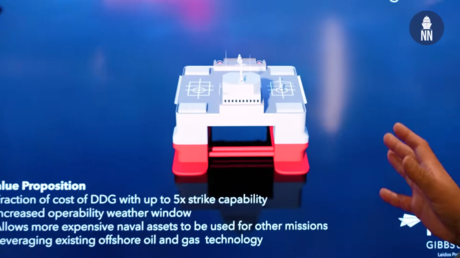
It has been proposed that unused oil platforms could be modified to serve as mobile supply depots and missile launchers for the US military in the Pacific.
A US military contractor called Gibbs & Cox, a naval architecture subsidiary of Leidos, presented the Mobile Defense/Depot Platform (MODEP) concept at a recent defense exhibition in Washington, DC. The concept aims to address capacity issues the US faces in maintaining forces in the Western Pacific, such as not having enough ships, missiles, or the ability to keep ships forwardly stationed. Dave Zook of Gibbs & Cox, described as the solutions architect and combat systems department manager, told Naval News that MODEP would be “a large floating island base” capable of independently operating at sea for almost six months in strategic locations away from shore. It could have either a supply configuration or a missile defense configuration as needed.
The supply version would solve the Navy’s current inability to reload missile launchers at sea via two cranes that can lift 100 tons each. The missile defense base version could hold up to 512 missile launch cells in a Vertical Launch System or up to 100 of the new Large Missile Launchers. Gibbs & Cox and Leidos also said the concept “reduces risks and costs associated with land-based defense systems.” Japan has considered using converted oil rigs as an alternative to its canceled Aegis Ashore missile defense program.
Both variants could travel at speeds of 5-8 knots to cover about 200 nautical miles per day and maintain stability in waves up to 60 feet tall. The concept calls for MODEP to have a range of 4,000 nautical miles without refueling, generate 6-20 megawatts of power, hold up to 2.3 million gallons of fuel, and host maintenance and repair facilities for warships.
According to Gibbs & Cox, there are up to six unused commercial oil rigs that could be converted for military use at relatively low cost due to current oil market oversupply, and the platforms could be ready within two years.
Neither the Pentagon nor the Navy have officially commented on the proposal.
